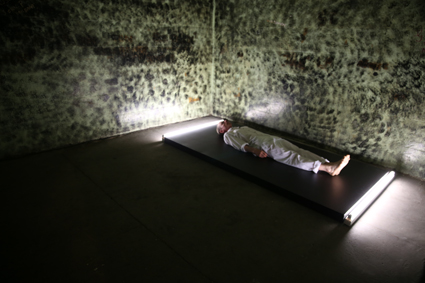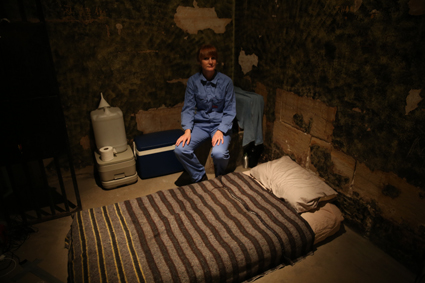The art of self-incarceration
Keri Glastonbury, Enduring Parallels

Jacobus Capone, Silent Elegy
photo Jamieson Moore
Jacobus Capone, Silent Elegy
Enduring Parallels was a weekend live performance exhibition held inside the historic sandstone edifice of The Lock-Up, Newcastle: a police lock-up from 1861-1982 that has since been decommissioned for use as a contemporary arts space. It’s a strange marriage arising from utility, not unlike Sydney College of the Arts housed in Callan Park, and is similarly impossible to sanitise.
The stench of urine still pervades the outdoor exercise yard where Adam Geczy (Big Arms) flexed his pecs and then religiously recorded his sets on chalkboards; Nicholas Shearer performed Boots in the disquieting portal of the padded cell; and Jacobus Capone enacted Silent Elegy in the old women’s lock-up, surrounded by walls covered in graffiti, including “Give Frazer The Razor Not Women’s Services.” written in what I imagine is red nail polish.
I arrived early on opening night, avoiding the crowd that had gathered at Civic Park to see Patricia Piccinini’s Skywhale (which unfortunately was dubbed #Skyfail as it remained only partly inflated and ‘beached az’). The first performance I encountered was co-curator Lottie Consalvo’s Near your sorrow, which was the perfect entrée: in a small single cell a woman in jeans and a T-shirt was singing along with a looped recording of another woman’s voice (which she would continue to do for the 17 hours the exhibition was open). The recorded voice belonged to the artist’s sister who committed suicide in 2010 and the audio was later discovered on her sister’s phone. This mournful and elegiac echo became a subliminal soundtrack to the rest of the exhibition as the noise of the opening night crowd had yet to permeate the space. I’d seen live art at The Lock-Up before as part of a few This Is Not Art programs, including Sarah-Jane Norman’s campy Surabaya Johnny and Fiona MacGregor’s starkly confrontational You Have the Body, but the simplicity of Lottie Consalvo’s work was equally immersive and exquisitely immanent as a futile attempt to cleave past and present.

Michaela Gleave,Doing Time, Time Doing, 2014
photo Jamieson Moore
Michaela Gleave,Doing Time, Time Doing, 2014
The heavy iron door of an adjacent cell was locked and a small surveillance monitor displayed the artist Michaela Gleave, who would remain self-incarcerated for 48 hours, with only a single bed, toilet and basic supplies. As you observed Gleave on the screen—sitting on the bed, doing some basic yoga stretches—she would also intermittently manually adjust a clock to reflect her perception of the passing time. Impressively, when I returned to the gallery on Sunday afternoon, Gleave was only 25 minutes behind the actual time (quite a feat when you also account for sleep). Doing Time/Time Doing was probably the most extreme of the endurance works and even a mediated sense of the claustrophobia was enough to give me heart palpitations.
Nicholas Shearer’s Boots drew on repetition as its modus-operandi as he sat on a chair surrounded by the worn leather cushioning of the padded cell, pulling his black Baxters off and on. This performance really encapsulated one of the difficulties of aestheticising such an historically loaded space (I know from discussions with past curators that inmates have committed suicide in this cell, and it still has a very foreboding 19th century feel). The soothing simplicity of Shearer’s performance, however, also reminded me of the recent phenomenon of autonomous sensory meridian response videos (Google it!), without the whispering. Another performance that had the act of labour at its core, was Rowena Fong’s With strings attached which had a Rumpelstiltskin motif, as the local clothing designer (from High Tea With Mrs Woo) spun “material waste into infinite cocoons of precious string” (program note). This struck a more craftily redemptive note, as drop spindles hung from the ceiling and Fong turned colourful material offcuts into twine.
On opening night I didn’t make it in for a consultation with Anastasia Klose, Your drunken fortune, but when I returned on Sunday afternoon I was able to sit down and seek her prescience. I told her a recent tale of woe, and she left me with words of wisdom from Morrissey, “I’ve seen it happen in other people’s lives, and now it’s happening in mine,” as she sipped red wine from a water tumbler. I was never one for drinking, or late nights—the wellsprings of this performance—but I can instinctively tap into these kinds of speculative conversations between women even though I remain stone cold sober. Klose brought the aesthetic of hand-drawn signs and lo-fi immediacy to the gallery, and the audience interaction gave this performance a private and unpredictable narrative element.
The only performance that I had conflicting feelings about was Jodie Whalen’s Between husband and wife, which involved Whalen and her husband writing long declarations of love to each other while sitting at a table in a far cell and then reading them out publically every 15 minutes in another space. Perhaps the intention was partly to make the audience uncomfortable, and god knows a marriage is as much a durational performance as any other—as the artists’ parents had often noted: “you don’t get this many years for murder.” Interpersonal relationships were also explored in Todd McMillan and Sarah Mosca’s You are as hopeless as me (study), which had a wonderful soundtrack by The Cocteau Twins.
Enduring Parallels co-curators Ineke Dane and Lottie Consalvo (who have both moved to Newcastle in the last few years) did a stellar job putting this exhibition together, which was as much a testimony to the indelible coherence of the 10 artists’ work in response to the physicality of the site, as it was the individual pieces (unfortunately, Sarah-Jane Norman, who was intending to do a telephonic work from Berlin, was a late withdrawal from the program due to technical issues, leading to a lack of contemporary Indigenous presence in the show). As romantic as the whole enterprise of art may be, especially in this context—where the site acts as a palimpsest for not only counter-discourses such as graffiti, but silhouettes of colonial forbears ghosted on the windows—the exhibition wasn’t overawed by its architecture, instead creating a live ‘event horizon.’ By definition The Lock-Up, as a kind of half-way house of detention, almost begs an engagement with endurance performance and, as the curators note, “Parallels with the past and present, infinity and the measurable, distance and time, value and immateriality, enduring love and memory, resonate in the performances” (program). The calibre of the artists involved in Enduring Parallels and the networks the curators tapped into bode well for The Lock-Up’s continued programming as a multi-disciplinary contemporary art space and I’m looking forward to their 2015 program.
–
Enduring Parallels, curators Ineke Dane, Lottie Consalvo, The Lock-Up, Newcastle, 28-30 Nov, 2014, www.thelockup.org.au
RealTime issue #125 Feb-March 2015 pg. 45






